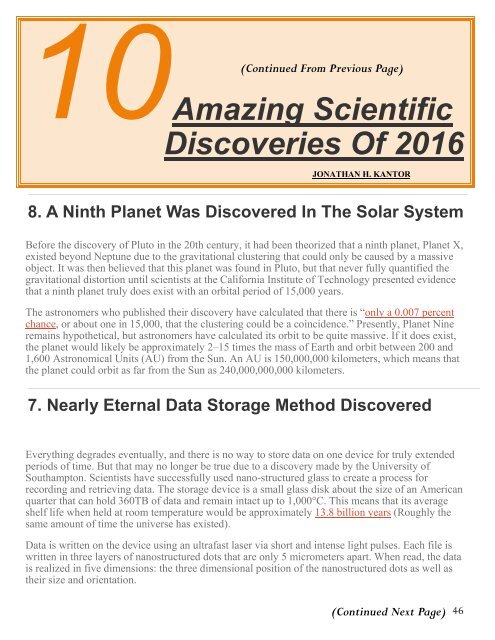February 2017 News Magazine
You also want an ePaper? Increase the reach of your titles
YUMPU automatically turns print PDFs into web optimized ePapers that Google loves.
10<br />
(Continued From Previous Page)<br />
Amazing Scientific<br />
Discoveries Of 2016<br />
JONATHAN H. KANTOR<br />
8. A Ninth Planet Was Discovered In The Solar System<br />
Before the discovery of Pluto in the 20th century, it had been theorized that a ninth planet, Planet X,<br />
existed beyond Neptune due to the gravitational clustering that could only be caused by a massive<br />
object. It was then believed that this planet was found in Pluto, but that never fully quantified the<br />
gravitational distortion until scientists at the California Institute of Technology presented evidence<br />
that a ninth planet truly does exist with an orbital period of 15,000 years.<br />
The astronomers who published their discovery have calculated that there is “only a 0.007 percent<br />
chance, or about one in 15,000, that the clustering could be a coincidence.” Presently, Planet Nine<br />
remains hypothetical, but astronomers have calculated its orbit to be quite massive. If it does exist,<br />
the planet would likely be approximately 2–15 times the mass of Earth and orbit between 200 and<br />
1,600 Astronomical Units (AU) from the Sun. An AU is 150,000,000 kilometers, which means that<br />
the planet could orbit as far from the Sun as 240,000,000,000 kilometers.<br />
7. Nearly Eternal Data Storage Method Discovered<br />
Everything degrades eventually, and there is no way to store data on one device for truly extended<br />
periods of time. But that may no longer be true due to a discovery made by the University of<br />
Southampton. Scientists have successfully used nano-structured glass to create a process for<br />
recording and retrieving data. The storage device is a small glass disk about the size of an American<br />
quarter that can hold 360TB of data and remain intact up to 1,000°C. This means that its average<br />
shelf life when held at room temperature would be approximately 13.8 billion years (Roughly the<br />
same amount of time the universe has existed).<br />
Data is written on the device using an ultrafast laser via short and intense light pulses. Each file is<br />
written in three layers of nanostructured dots that are only 5 micrometers apart. When read, the data<br />
is realized in five dimensions: the three dimensional position of the nanostructured dots as well as<br />
their size and orientation.<br />
(Continued Next Page)<br />
46


















